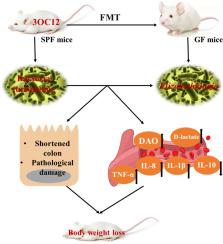Science of the Total Environment ( IF 8.2 ) Pub Date : 2021-03-11 , DOI: 10.1016/j.scitotenv.2021.146347 Wei Cheng , Zhenyu Wang , Yi Xiong , Zhifeng Wu , Xiang Tan , Yapeng Yang , Hang Zhang , Xi Zhu , Hong Wei , Shiyu Tao

|
As a quorum sensing signal molecule, N-(3-oxododecanoyl)-homoserine lactone (3OC12) regulate the population behavior of microorganisms. Many studies have proved that 3OC12 harm the physiological function of host intestinal epithelial cells. However, the detrimental effects of 3OC12 on intestinal health need verification in animals. Besides, the role of gut microbiome in 3OC12-induced intestinal damage also needs further understanding. In our study, 3OC12 was first administered to specific pathogen-free (SPF) mice, then the fecal microbiome of SPF mice was transplanted into germ-free (GF) mice to reveal the effects of 3OC12 on intestinal health and regulatory mechanisms of the intestinal microbiome. 3OC12 treatment significantly decreased body weight, shortened colonic length, disrupted the morphology of the colonic epithelium and increased the histopathological score of the colon in SPF mice. The levels of diamine peroxidase, D-lactate, TNF-α, IL-1β, and IL-8 were found to be significantly elevated in the serum of 3OC12 mice, while the levels of IL-10 were significantly reduced. Besides, the fecal microbial community of mice was also altered in the 3OC12-treated SPF mice. The results of fecal microbial transplantation (FMT) experiment showed that the phenotypes in SPF mice were almost reproduced in GF mice, manifested by body weight loss, colon damage and changed in serum chemical markers. More importantly, a joint analysis of fecal microbes in SPF and GF mice revealed Feature14_Elizabethkingia spp. was common differential bacteria in the feces of two kinds of mice treated with and without FMT. Our results demonstrated that 3OC12 challenge led to systemic inflammation and body weight loss in mice by disrupting intestinal barrier function, in which gut microbiome played a key role. These findings increased our understanding of the mechanism of intestinal injury caused by 3CO12, providing new ideas for the prevention and therapy of diseases caused by bacterial infection from the perspective of intestinal microbiome.
中文翻译:

N-(3-氧十二烷酰基)-高丝氨酸内酯通过干扰小鼠肠道微生物组破坏肠屏障并诱导全身性炎症
作为群体感应信号分子,N-(3-氧十二烷酰基)-高丝氨酸内酯(3OC12)调节微生物的种群行为。许多研究证明3OC12会损害宿主肠道上皮细胞的生理功能。但是,3OC12对肠道健康的有害影响需要在动物中进行验证。此外,肠道微生物组在3OC12引起的肠道损伤中的作用也需要进一步了解。在我们的研究中,首先将3OC12施用给特定的无病原体(SPF)小鼠,然后将SPF小鼠的粪便微生物组移植到无病菌(GF)小鼠中,以揭示3OC12对肠道健康和肠道调节机制的影响微生物组。3OC12治疗可显着减轻体重,缩短结肠长度,破坏了结肠上皮细胞的形态,并增加了SPF小鼠结肠的组织病理学评分。发现3OC12小鼠的血清中二胺过氧化物酶,D-乳酸,TNF-α,IL-1β和IL-8的水平显着升高,而IL-10的水平显着降低。此外,在3OC12处理的SPF小鼠中,小鼠的粪便微生物群落也发生了改变。粪便微生物移植(FMT)实验的结果表明,SPF小鼠的表型几乎在GF小鼠中复制,表现为体重减轻,结肠损伤和血清化学标志物改变。更重要的是,对SPF和GF小鼠的粪便微生物进行联合分析发现 发现3OC12小鼠的血清中IL-8和IL-8显着升高,而IL-10的水平显着降低。此外,在3OC12处理的SPF小鼠中,小鼠的粪便微生物群落也发生了改变。粪便微生物移植(FMT)实验的结果表明,SPF小鼠的表型几乎在GF小鼠中复制,表现为体重减轻,结肠损伤和血清化学标志物改变。更重要的是,对SPF和GF小鼠的粪便微生物进行联合分析发现 发现3OC12小鼠的血清中IL-8和IL-8显着升高,而IL-10的水平显着降低。此外,在3OC12处理的SPF小鼠中,小鼠的粪便微生物群落也发生了改变。粪便微生物移植(FMT)实验的结果表明,SPF小鼠的表型几乎在GF小鼠中复制,表现为体重减轻,结肠损伤和血清化学标志物改变。更重要的是,对SPF和GF小鼠的粪便微生物进行联合分析发现 表现为体重减轻,结肠损伤和血清化学标志物改变。更重要的是,对SPF和GF小鼠的粪便微生物进行联合分析发现 表现为体重减轻,结肠损伤和血清化学标志物改变。更重要的是,对SPF和GF小鼠的粪便微生物进行联合分析发现Feature14_Elizabethkingia spp。是使用FMT和未使用FMT处理的两种小鼠粪便中常见的差异细菌。我们的结果表明,3OC12攻击通过破坏肠道屏障功能而在小鼠体内导致肠道炎症和体重减轻,其中肠道微生物组起着关键作用。这些发现增加了我们对3CO12引起的肠道损伤机理的理解,从肠道微生物组的角度为细菌感染引起的疾病的预防和治疗提供了新的思路。






























 京公网安备 11010802027423号
京公网安备 11010802027423号